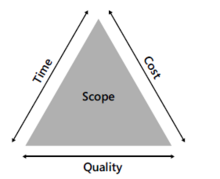The Critical Path Method (CPM) in Project Management
According to the Project Management Institute (PMI), project management is the application of knowledge, skills, tools and techniques to project activities in order to meet project requirements and objectives.[1] The challenging task of managing projects can be supported by an operation reserach technique called the Critical Path Method (CPM). The CPM is a mathematically-network based algorithm in which can be used for planning, scheduling and monitoring project progress. [2]
The technique developed in late 1950s uses information from a work breakdowm structure (WBS) in a network representation to display interrelationships and dependencies between project activities that must be accomplished to complete a project. The technique is used for analyzing projects by determining the longest sequence of tasks through a project network, called the critical path. This determines the shortest possible time to complete the project as well as which tasks or activities should be of extra focus in the project. Furthermore, based on acquired information from the CPM, the next question could be if it is possible to shorten the project in order to finish within certain deadline. [2][3][4]
The article includes brief introduction and background of the CPM method in project management together with the methodology behind it. An example of the method is carried out step-by-step and a solution is presented. Following is a discussion on time-cost trade offs in project acceleration together with an example of project crashing. Lastly, the article ends on a brief summary on the benefits and limitation of the CPM method within the field of project management.
Contents |
Overview
Introduction

Organizations across the world and different sectors have been embracing project management as a way to improve project results. The increased awareness and acceptance indicates that the application of knowledge, skills, tools and techniques can have significant impact on project success.[6][1]
All projects are carried out under certain constraints. The most traditional ones, the constraints of cost, time and scope represent together the iron triangle of project management, which can be seen in Figure 1. Each constraint forms the vertices with quality as the central theme and together it indicates that projects must be delivered within agreed cost and time and furthermore to meet the agreed scope and customer quality requirements. The three constraints are aligned to each other and therefore closely linked. That is, changes to one of them will likely affect the others, or impact the quality of the project.
Project management is accomplished through the appropriate application of five processes: [1]
- Initiating
- Planning
- Executing
- Monitoring and Controlling
- Closing
Each and every organization can be involved in a project of any size duration and complexity level at any given time. It is worthwhile to note that project planning, scheduling and monitoring is a major part involved in project management. These are those areas in which the critical path method can be of good support within the challenging task of managing projects.
Background
Application and use
Methodology
The Project Network
CPM Example
Consdideration of Time-Cost trade-offs
Project Crashing Example
Once the critical path and timeing of activities has been identified - the next question is if it is possible to shorten the project in order to finish within a certein deadline.
Here is maybe possible to do an example of project crashing.
Benefits of CPM in project planning
Limitations of CPM
References
- ↑ 1.0 1.1 1.2 Project Management Institute. (2008). A Guide to the Project Management Body of Knowledge. 4th Edition. p. 6. USA. ISBN 9781933890517
- ↑ 2.0 2.1 Larson, E. W & Gray, C. F. (2014). Project Management - The Managerial Process. 6th edition, p. 161. USA: NY. ISBN 9781259010705
- ↑ Newbold, R.C. (1998). Project Management in the Fast Lane – Applying the Theory of Constraint. USA: FL. ISBN 9781498738064
- ↑ Larsen, J. & Clausen, J., (2009). Course material in Networks and Integer Programming Supplementary at DTU - Notes to Networks and Integer Programming. Retrieved from campusnet.dtu.dk
- ↑ Robert K. Wysocki, 2009, Effective Project Management: Traditional, Agile, Extreme. Fifth Edition. Indianapolis. [Available online on Google books]
- ↑ Project Management Institute. (2010). The Value of Project Management. Available Online Version
- ↑ International Organization for Standardization (2012) ISO 21500 – Guidance on Project Management.